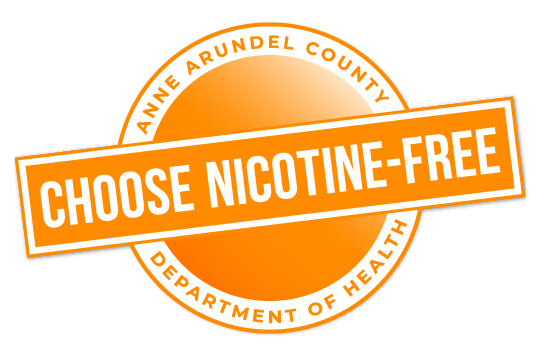What Anne Arundel County teens think about smoking:
- The majority of teens think most of their peers smoke. In reality, only 4% of Anne Arundel County teens currently smoke.
- County teens want to influence their younger siblings and young children not to smoke.
- By being aware of tobacco industry marketing efforts, young people can be better prepared to resist them.
Over 3,000 teens and preteens are sucked in daily:
- Each day, about 2,000 people younger than 18 years smoke their first cigarette and over 300 people younger than 18 years become daily cigarette smokers.
- In 2021, 0.6% of Anne Arundel County high school students reported smoking cigarettes daily.
- Smoking addiction starts at a young age. Nearly 9 out of 10 adults who smoke cigarettes daily first try smoking by age 18.
Bad for your looks:
- Smoking can cause your skin to be dry and lose elasticity, leading to wrinkles and stretch marks.
- Tar, the sticky brown substance in tobacco products, stains smokers’ fingers and teeth.
- Smoking makes you stink! Your hair, breath and clothes smell bad.
Bad for your health:
- Smoking is linked to slowed growth of lung function in teens. They cannot run as fast or far. Smokers suffer from shortness of breath three times more than nonsmokers.
- Tobacco abuse harms every organ in the body. It has been linked to leukemia, cataracts and pneumonia, and accounts for about one-third of all cancer deaths.
- People who smoke cigarettes are 15 to 30 times more likely to get lung cancer or die from lung cancer than people who do not smoke.
- Cigarette smoke is toxic and poisonous to the human body. It contains about 7,000 chemical agents, including almost 70 that cause cancer.
- Some of the toxins found in cigarette smoke are found in items such as rat poison, toilet cleaners and formaldehyde, which is used to preserve dead animals.
- Not feeling good (and your parents smoke)? Every year, secondhand smoke causes more than 202,000 asthma episodes and 790,000 doctor visits due to ear infections.
It’s a killer:
- Smoking is the single largest cause of preventable disease and death in the United States.
- Cigarette smoking kills more than 480,000 Americans each year. That's more than 50 people every hour.
- Infants exposed to secondhand smoke after birth are more likely to die from sudden infant death syndrome (SIDS) than infants who are not exposed to secondhand smoke. SIDS is the sudden, unexplained, unexpected death of an infant in the first year of life.
- Of kids now under 18 who live in Maryland, 108,000 will ultimately die prematurely from smoking.
- More deaths are caused each year by tobacco use than by HIV, illegal drug use, alcohol use, motor vehicle injuries, suicides and murders combined.
- Smoking reduces life expectancy for smokers by at least 10 years.
The bad news about addiction:
- Nicotine is a drug found naturally in tobacco. It’s as addictive as heroin and cocaine.
- It takes only 8 seconds for nicotine to reach the brain.
- Teens can experience tobacco dependence within a day of first inhaling, including strong urges to smoke, and anxiety or irritability.
- It can be hard to quit. In 2021, 60.2% of youth who currently used tobacco products reported that they had stopped using all tobacco products for one day or longer in the past year because they were trying to quit.
- Some people smoke because they think it helps them relax. A new study suggests otherwise – smoking actually triggers stress. The truth is that smokers are addicted to the nicotine in tobacco; as the nicotine from one cigarette wears off, they start to crave another and become nervous and tense. Doesn’t sound very relaxing!
Spit tobacco is disgusting and dangerous:
- Smokeless or spit tobacco is not a safe alternative to smoking. It contains the same addicting and cancer-causing chemicals as cigarettes.
- Using spit tobacco stains your teeth and can make them loose and fall out.
- It also greatly increases your chances of getting cancer of the tongue, gums, cheeks and lips. These cancers often require surgery to remove the diseased part. Young people have become disfigured due to these surgeries.
E-cigarettes are not the safer choice:
- Most e-cigarettes contain nicotine. Nicotine can have harmful effects and causes addiction.
- Health risks are not yet known, so why take the risk?
- It is not just water vapor. Aerosols can contain heavy metals and cancer causing agents. It is not as safe as clean air.
What about other kinds of tobacco?
- Cigars are not a safe alternative to cigarettes. Regular cigar smoking greatly increases your risk for cancers of the lung, mouth, larynx and esophagus.
- Cigars contain the same addictive, toxic and carcinogenic compounds found in cigarettes. In fact, a single large cigar can contain as much tobacco as an entire pack of cigarettes.
- Cigarettes using “natural” tobacco are not safer than those with processed tobacco.
- Bidis produce three times the amount of carbon monoxide and nicotine, and more than five times the amount of tar, produced by cigarettes using processed tobacco.
- Kreteks — sometimes referred to as clove cigarettes — also contain higher concentrations of nicotine, tar and carbon monoxide and put users at increased risk of acute lung injury.
- Although many hookah smokers think it is less harmful than smoking cigarettes, water pipe smoking still delivers the addictive drug nicotine and is at least as toxic as cigarette smoking.
- Electronic cigarettes are not a safe alternative. They too deliver nicotine to the body which leads to various health issues, including nicotine poisoning and cardiovascular disease.
Tobacco sales and e-cigarette marketing to teens is big business:
- Cigarette and smokeless tobacco companies spend billions of dollars each year to market their products. The money cigarette and smokeless tobacco companies spent in 2019 on U.S. marketing amounted to about $22.5 million each day, or about $25 for every person (adults and children) in the United States per year.
- Tobacco companies intensely market to teens. Why? To find replacement smokers for those who die or quit.
- In all top 2022 films overall, there was an average of 10 tobacco incidents per film. An estimated 21 million youth and young adults were potentially exposed to tobacco imagery in top films watched on streaming platforms in 2022, and an estimated 104 million youth and adults were exposed to tobacco imagery in top films watched in theaters in 2022.
- In 2022, tobacco companies spent an estimated $95.4 million advertising their products in Maryland.
- The average pack-a-day smoker pays $12.05 per pack in Maryland, adding up to $4,398 per year. That’s a lot of money to pay to hurt yourself.
- E-cigarette advertisements are taking the same approach as tobacco companies.
- E-cigarette advertisements are targeting youth through retail stores, the Internet, TV/movies and magazines/newspapers.
- The amount of money spent on e-cigarette advertising and promotion went from $769 million in 2021 to nearly $860 million in 2022.
What is environmental tobacco smoke?
Environmental tobacco smoke includes secondhand and thirdhand smoke:
Secondhand smoke comes from burning cigarettes, cigars or pipes, or smoke exhaled by a smoker. The concentration of chemicals in secondhand smoke is actually higher than the smoke inhaled directly from cigarettes. This means that if you live or hang out around smokers, you breathe the same stuff they do-and more!
Why it’s harmful:
- There are more than 7,000 chemicals in commercial tobacco smoke, including hundreds of chemicals that are toxic and about 70 that can cause cancer.
- It makes you more likely to get sick with everything from colds to pneumonia. You could miss out on a lot of fun stuff being sick all the time!
- Secondhand smoke can give you cancer or heart disease, and if you have asthma it can make it much worse.
- Because your lungs are still growing, secondhand smoke may permanently hurt your ability to breathe. This can make playing sports and running a lot harder.
- Thirdhand smoke: When tobacco is burned toxic smoke particles cling to surrounding areas long after the smoke has cleared. Studies show that these particles react with pollutants in the air to release cancer-causing toxins. The smell of tobacco on a person’s clothes and hair or in room is how our nose warns us that toxins are present!
There is no safe level of exposure to environmental tobacco smoke. If you have parents, relatives or friends who smoke, ask them not to smoke indoors or in the car, even if the windows are open, smoke can still get trapped inside.
Tip: Try to keep the conversation polite and cool. You’ll get better results from a discussion than an argument.
Yeah, smoking stinks. It stinks up your breath and your clothes. But it really stinks because smoking causes cancer, lung disease, heart disease…and death!

